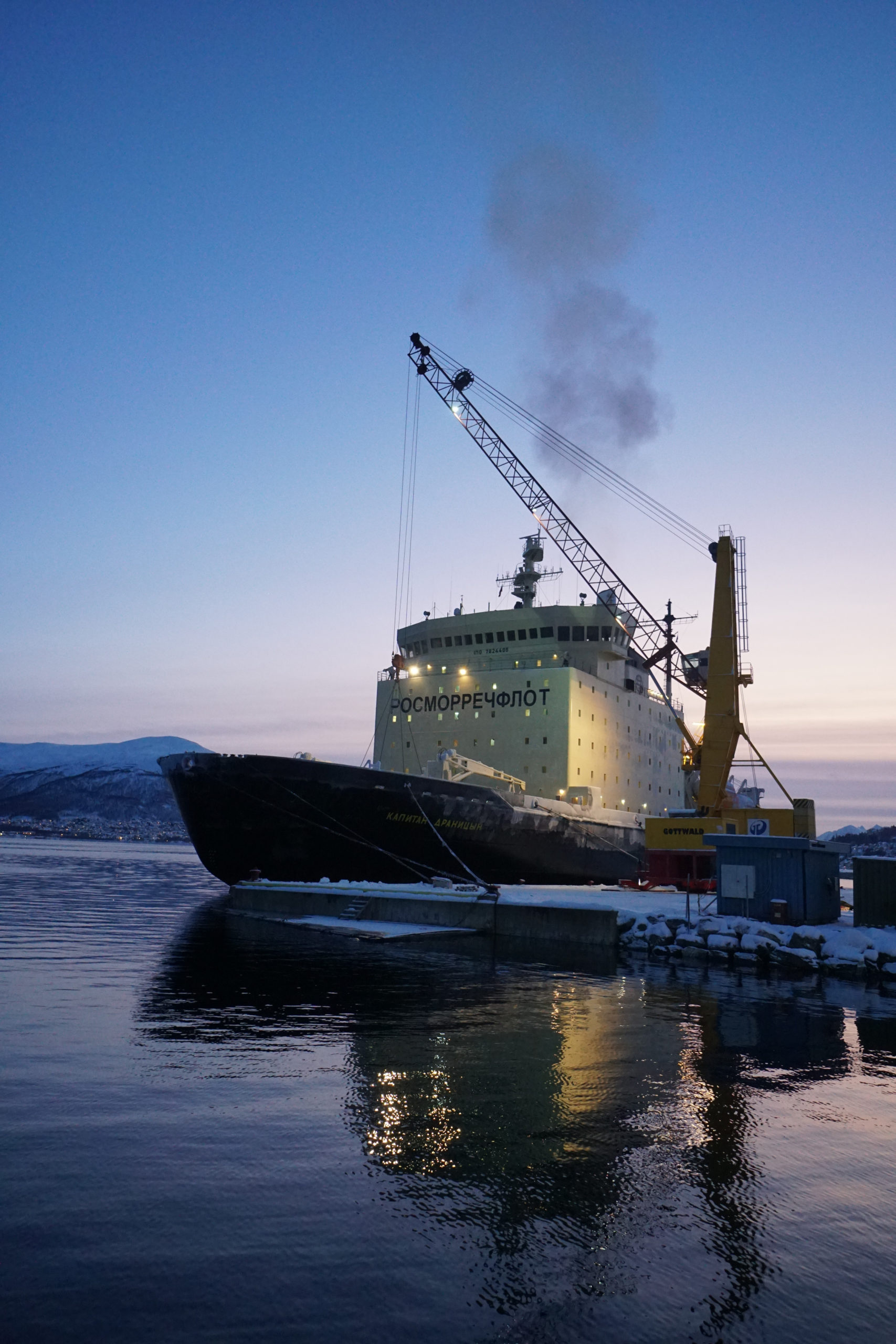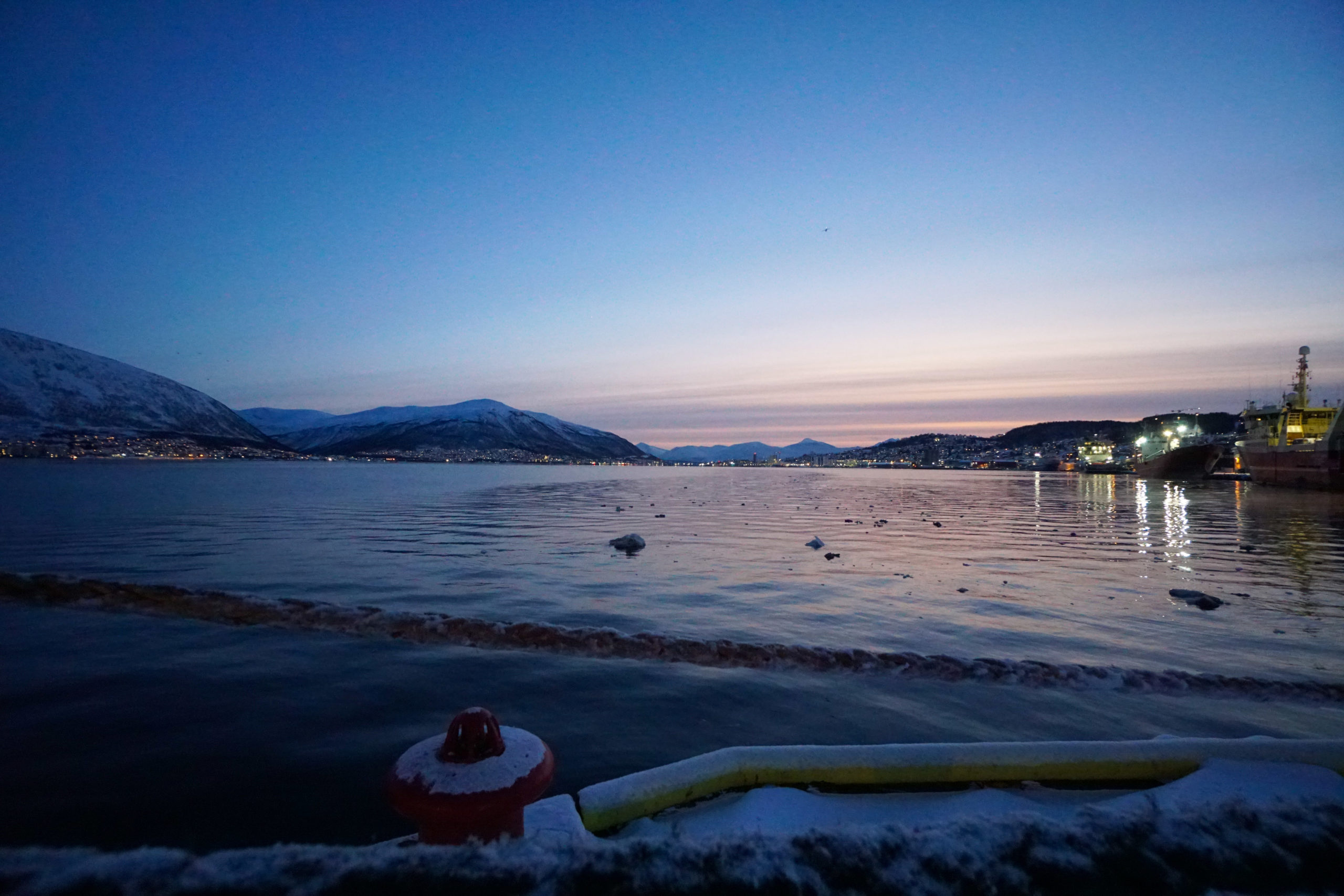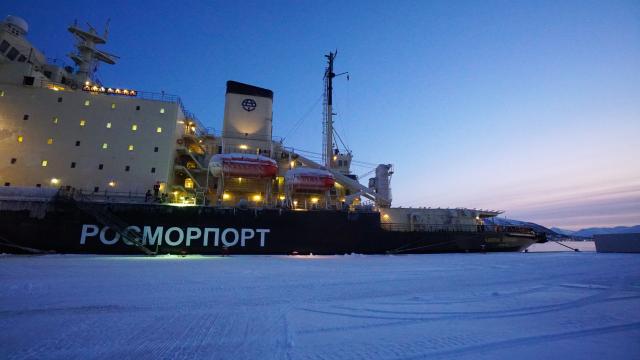Most places that built their economies around catering to cruise ship passengers are suffering. Stay-at-home orders intended to contain the spread of COVID-19 have cancelled holidays around the world. But Arctic seaports like the popular tourist destination of Tromsø, Norway are still busy, despite the disappearance of the cruise ships that usually stop by every month.
While in Tromsø this past winter to report on new science about Arctic animals, I learned how the ports would be able to sustain heavy traffic despite the current global downturn in tourism. Thanks in part to increasing global temperatures — the Arctic is warming faster than anywhere on the planet and sea ice is the thinnest it has been since scientists started measuring it — commercial activity in Arctic waters has been booming for a while now. Fishing vessels, cargo ships, bulk carriers, and tankers have been checking in to the Tromsø port more often than cruise liners for the past three years, statistics gathered and published by port officials before the pandemic show. The total amount of ships calling in to the port has been steadily increasing for the past six.
And the port’s maritime director, Knut-Ivar Bendiksen, told me in a recent follow-up conversation that though Tromsø has hosted no cruise ships at all after the outbreak of COVID-19, there has actually been an uptick in activity related to the transport of goods and cargo. “We will probably lose money this year, but our economy is solid and we will still manage and be here for years to come,” Bendiksen said.
Vladimir Putin, the president of the country with the most Arctic coastline, predicted the pattern of industrial growth during a speech broadcasted live in 2017. “The global warming trend will continue, meaning that the navigation period in the Arctic zone will get longer,” Putin said. “This means that the Northern Sea Route will be used much more actively than now,” he added. There, Putin was referring to the Arctic’s most trafficked shipping lane. Though the route lies entirely in the Russian Exclusive Economic Zone, its popularity affects ports in other countries, too. Most of the ships that cross the Arctic pass through Norwegian territorial waters at some point on their journeys.
Putin’s prediction about the Northern Sea Route has proven spot on. Recently published data show that in 2019, the ships that sailed through it carried nearly 60 per cent more tonnes of cargo last year than were carried in 2018. The amount was almost 200 per cent more than what was brought over in 2017.
The presence of other kinds of ships in the Arctic is increasing as well. Eight countries are in the process of constructing or planning 29 new icebreakers — expensive ships with strengthened hulls and the power to push straight through the thickest levels of sea ice — according to a document I obtained from the US Coast Guard. Though Russia already has some 41-odd available, government owned icebreakers, more than the number all other countries with Arctic territory have combined, the state is investing in 11 new ones. The Russian icebreaker I snapped a picture of this January, above, runs on diesel, but seven of the new ones will be nuclear-powered. Putin predicted that kind of upgrade in his 2017 speech, too. “I can say with confidence that Russia’s power and capabilities will expand as we develop the Arctic region,” he said.

America lags many nautical miles behind Russia in icebreaking capability but is among the eight working to catch up now. The US Coast Guard has only two icebreakers in commission today, but the funds to build an additional few have been secured, Commander William Woityra confirmed this March in an email he sent me from aboard one of the two currently functional icebreakers. The first of three new ships should be ready to deploy by 2025, he wrote.
Military ships are also frequent travellers in the Arctic — almost as many naval vessels called into Tromsø last year as did cruise ships. In January, I spotted two Norwegian Skjold-class corvettes, pictured at the top of this article, sailing in to Tromsø.
“They track the Russians as part of the NATO safety umbrella,” Bill Lind, former Vice President of Vard Marine, a shipping company, told me. “The Norwegian corvettes (small destroyers) have their topsides faceted and angled to greatly reduce radar detection.”
On May 1st, that umbrella was unveiled again during a joint American and British anti-submarine exercise that took place off the coast of northern Norway. One nuclear-powered submarine, four warships, a maritime reconnaissance plane, and over a thousand sailors participated, The Barents Observer reported.

The increased presence of ships in the Arctic has consequences for the sensitive marine ecosystem that supports them. Largely because it’s the cheapest, Heavy Fuel Oil (HFO) has become the most popular fuel choice in the commercial shipping industry. But the tar-like substance poses more of a risk to the Arctic than do other fuel oils, like diesel, which is also relatively inexpensive.
Since fuel sticks to ice and infrastructure is sparse in the Arctic, spills are expected to take longer to clean up there. HFO has the added detriment of emulsifying in water, so it persists in the ocean longer than other fuels. If HFO were to spill during the Arctic winter, when days are darkest, a cleanup could be impossible. Though the oil is prohibited in Antarctic and Icelandic waters for some of these reasons, there is still no widespread ban against carrying or using the fuel in the Arctic.
The noise generated from vessels moving through the Arctic is another cause for concern to the ecosystem, says Miyoko Sakashita, the Oceans Director and Senior Counsel at the Centre for Biological Diversity. “Shipping noise is one of the loudest things in the ocean, and really disturbing for animals that use sound to forage,” Sakashita said. Some endangered animals in the Arctic, like polar bears, depend on large, cohesive swaths of ice to hunt. And since that ice is being increasingly cut up by the growing number of icebreakers passing through, she says “they’re finding they have to swim further and are starving.”
Back in Tromsø, the port’s maritime director, Knut-Ivar Bendiksen, said that it has taken steps to prevent some of the harm the growing shipping industry is causing the ecosystem. The port is increasing its capacity to allow docked boats to plug into power from the shore so they don’t have to run their generators while there, he said. This can reduce noise and emissions. And when cruise ships were more common, the port charged the less environmentally friendly ones more dues and fees than the efficient liners, according to their established Environmental Port Index (EPI).
When the global lockdowns lift, the cruise industry may still struggle as a result of its mishandling of the spread of COVID-19. More than 2,000 people tested positive for the novel coronavirus while onboard or after disembarking one of 54 ocean-going cruises, and at least 65 passengers died as a result, a team of investigative journalists at The Miami Herald reported. (No cases were linked to vessels in Tromsø, the port’s website states.)
But even if tourists do avoid travelling by cruise in the future, Arctic seaports could make up for the lost income by starting to tax inefficient commercial vessels like they have been taxing the liners. “There are no current plans for this, but this will be considered along with other ports using the EPI later on,” Bendiksen told me. The environmental pay-off could be one perk of COVID-19 enjoyed for generations to come.
Chiara Eisner is a multimedia investigative journalist whose work has focused on international politics, criminal justice, and science and technology. More of her reporting can be found here. Send her a tip: eisnerchiara@gmail.com
